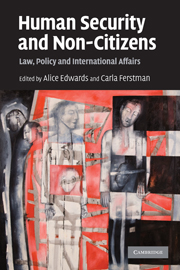Book contents
- Frontmatter
- Contents
- About the editors
- About the contributors
- Preface
- Acknowledgements
- Part I Human security, human rights and human dignity
- Part II Physical and legal security, armed conflict and refuge
- 2 The value of the human security framework in addressing statelessness
- 3 Protection and empowerment: strategies to strengthen refugees' human security
- 4 From here to where? Refugees living in protracted situations in Africa
- 5 Once we were warriors: critical reflections on refugee and IDP militarisation and human security
- 6 Human security and protection from refoulement in the maritime context
- Part III Migration, development and environment
- Part IV National security and the ‘war on terror’
- Index
3 - Protection and empowerment: strategies to strengthen refugees' human security
Published online by Cambridge University Press: 17 February 2011
- Frontmatter
- Contents
- About the editors
- About the contributors
- Preface
- Acknowledgements
- Part I Human security, human rights and human dignity
- Part II Physical and legal security, armed conflict and refuge
- 2 The value of the human security framework in addressing statelessness
- 3 Protection and empowerment: strategies to strengthen refugees' human security
- 4 From here to where? Refugees living in protracted situations in Africa
- 5 Once we were warriors: critical reflections on refugee and IDP militarisation and human security
- 6 Human security and protection from refoulement in the maritime context
- Part III Migration, development and environment
- Part IV National security and the ‘war on terror’
- Index
Summary
Introduction
Today, armed conflicts within states are more frequent than those between nations, civilians are increasingly direct targets, and forced displacement within and beyond borders is often a defining feature. Phenomena such as globalisation, terrorism and climate change also present challenges which clearly transcend national borders. These developments have led to a reassessment in recent years of the concept of security, which has come to be understood as extending beyond national security interests to encompass the security of individuals – in other words, to include the concept of human security.
At the same time, there has been a growing recognition that threats to international, state and human security are interconnected and transnational in nature and that international cooperation must therefore be strengthened if responses to these threats are to be effective. International efforts to do this around the time of the millennium accordingly sought to reinforce collective efforts to strengthen peace and security, development and human rights as the three pillars of the United Nations. As the 2005 World Summit Outcome document acknowledged, these three pillars of the UN system are ‘the foundations for collective security and well-being [and] are interlinked and mutually reinforcing’.
- Type
- Chapter
- Information
- Human Security and Non-CitizensLaw, Policy and International Affairs, pp. 82 - 124Publisher: Cambridge University PressPrint publication year: 2010
- 2
- Cited by



